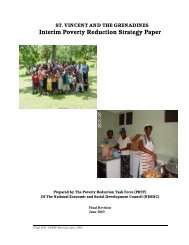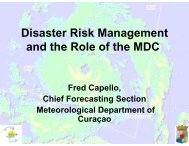The Anatomy of A Silent Crisis The Anatomy of A Silent Crisis
The Anatomy of A Silent Crisis The Anatomy of A Silent Crisis
The Anatomy of A Silent Crisis The Anatomy of A Silent Crisis
- TAGS
- anatomy
- www.bb.undp.org
Create successful ePaper yourself
Turn your PDF publications into a flip-book with our unique Google optimized e-Paper software.
102 Forum 2009: Climate Change – <strong>The</strong> <strong>Anatomy</strong> <strong>of</strong> a <strong>Silent</strong> <strong>Crisis</strong><br />
92. According to WHO-UNICEF World Malaria Report<br />
(2008) 247 million Malaria episodes resulting in<br />
880,000 deaths were reported in 2006; 80% <strong>of</strong><br />
which occurred in Africa. <strong>The</strong> Food and Agriculture<br />
Organization (FAO) <strong>of</strong> the United Nations estimated<br />
that more than 900 million are afflicted with hunger.<br />
93. Connor, S. et al. (2008). “A collaborative epidemic<br />
early warning and response initiative in Ethiopia.”<br />
94. <strong>The</strong>se statistics are based on the same baseline<br />
study by WHO. It is assumed that the baseline global<br />
disease levels independent <strong>of</strong> climate change stay<br />
constant, as population growth, which increases the<br />
amount <strong>of</strong> people susceptible to disease, and efforts<br />
to combat the disease <strong>of</strong>fset each other. Please<br />
refer to “Notes on report methodology C.”<br />
95. Byrd, D., et al. (2008): “What if we stopped burning<br />
fossil fuels today?.” EarthSky, Program #4190 <strong>of</strong> the<br />
Earth & Sky Radio Series.<br />
96. Oxfam. (2009): “Ethiopia Drought.” Oxfam Great<br />
Britain. http://www.oxfam.org.uk/oxfam_in_action/<br />
emergencies/ethiopia_drought.html.<br />
97. Malnourishment estimates are based on data from<br />
FAO for 2000-2003.<br />
98. Red Cross. (2009): “Case Study Africa.” Red Cross,<br />
Red Cross/Red Crescent Climate Guide, p.71.<br />
http://www.climatecentre.org/downloads/File/<br />
RCRC_ClimateG_Africa.pdf.<br />
99. 29% <strong>of</strong> open sea fisheries were in a state <strong>of</strong><br />
collapse in 2003, defined as a decline to less<br />
than 10% <strong>of</strong> their original yield. It is predicted that<br />
there will be virtually no fish left in the oceans by<br />
2050, (predominantly due to unsustainable fishing<br />
practices fuelled by the advent <strong>of</strong> improved fishing<br />
technology like better nets, and further exacerbated<br />
by the effects <strong>of</strong> climate change such as rising<br />
temperatures). Cheung, W., et al. (2009): “Projecting<br />
global marine biodiversity impacts under climate<br />
change scenarios.” Fish and Fisheries, January, DOI:<br />
10.1111/j.1467-2979.2008.00315.x and Black, R.<br />
(2006): “‘Only 50 years left’ for sea fish.” BBC News,<br />
November 2. http://news.bbc.co.uk/2/hi/science/<br />
nature/6108414.stm.<br />
100. Coral reefs are negatively impacted by increases<br />
ocean temperatures, rising sea levels, and more<br />
frequent and severe storms. <strong>The</strong>se factors can<br />
cause large scale coral bleaching. It is possible<br />
for coral to recover from short term periods <strong>of</strong><br />
bleaching, but longer term stresses increase coral<br />
mortality and entire reefs can die out. Coral Reef<br />
Alliance. (2009): “Rising tides, temperatures and<br />
costs to reef communities.” Coral Reef Alliance.<br />
http://www.coral.org/node/126.<br />
101. World Tourism Organization. (2003): “Climate<br />
change and tourism.” World Tourism Organization,<br />
Proceedings <strong>of</strong> the 1st International Conference on<br />
Climate Change and Tourism, p.35. http://www.<br />
world-tourism.org/sustainable/climate/final-report.pdf.<br />
102. This figure is based on (1) Earth Trend’s projected<br />
workforce for 2004 <strong>of</strong> 2.5 billion in Africa, Asia/<br />
Pacific islands, Middle East, Latin America and the<br />
Caribbean, (2) combined with World Bank estimates<br />
for the percentage <strong>of</strong> the workforce employed<br />
in agriculture, fisheries or livestock equalling 1.4<br />
billion, (60% for SSA, Asia/Pacific and 19% for Latin<br />
American (assumption is made that 19% also is<br />
applicable for the Caribbean and 30% is assumed<br />
for North Africa and the Middle East based on<br />
country statistics from UN data)) and (3) WTTC<br />
estimate <strong>of</strong> 160,000 being employed in tourism and<br />
travel in these regions. References: Earth Trend<br />
Statistics, (2009), World Travel and Tourism Council<br />
Statistics, (2009), WFP. (2009): “World Hunger.”<br />
World Food Programme http://www.wfp.org/hunger,<br />
UN Data Statistics, (2009) and World Bank (2006):<br />
“06 World Development Indicators.” <strong>The</strong> World Bank<br />
Group. http://devdata.worldbank.org/wdi2006/<br />
contents/Section3_1.htm.<br />
103. This number is based on our update <strong>of</strong> the Stern<br />
Report’s PAGE 2002 model. We assume that a 1%<br />
increase in GDP reduces poverty by 2%. See “Notes<br />
on report methodology D.” for further description.<br />
104. Poverty statistics used in the Stern model: World<br />
Bank Statistics, (2007), (based on 2005 PovcalNet<br />
values). World Bank published new up poverty







